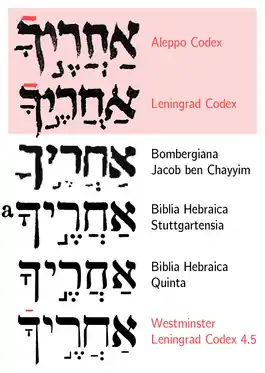Rafe
In Hebrew orthography the rafe, or more commonly spelt raphe (Hebrew: רָפֵה pronounced [ʁaˈfe]), is a diacritic (⟨ ֿ ⟩), a subtle horizontal overbar placed above certain letters to indicate that they are to be pronounced as fricatives.
| ֿ | |
| Similar appearance | macron |
| פֿיש | |

It originated with the Tiberian Masoretes as part of the extended system of niqqud (vowel points), and has the opposite meaning of dagesh qal, showing that one of the letters בגדכפת is to be pronounced as a fricative and not as a plosive, or (sometimes) that a consonant is single and not double; or, as the opposite to a mappiq, to show that the letters ה or א are silent (mater lectionis).
The rafe generally fell out of use for Hebrew with the coming of printing, although according to Gesenius (1813) at that time it could still be found in a few places in printed Hebrew Bibles, where the absence of a dagesh or a mappiq was particularly to be noted.[1] (e.g. Exodus 20:13,14,15; Deuteronomy 5:13,17,18,19; 2 Samuel 11:1; Isaiah 22:10; Jeremiah 20:17; Psalm 119:99; Zechariah 5:11)
In some siddurs (e.g. those printed by ArtScroll) a diacritical symbol, typographically the same as the rafe, but utterly unrelated, is used to mark instances of "moving sheva" (Shva Na). [2]
The rafe is similar in function to the buailte (dot above, denoting lenition) in the old-style Irish alphabet.
Yiddish/Ladino
It retained some currency in Yiddish and Ladino.
In Yiddish the rafe distinguish פּ (p) from פֿ (f) and in Hebrew or Aramaic words also to distinguish ב (b) and בֿ (v, in Yiddish words you use װ for that sound) and תּ (t) from תֿ (s, in Yiddish words you use ס for that sound).
In Ladino the rafe, called a varrica (“little crossbar”), looks more like a breve-shaped diacritic (ﬞ ) on top of the letter (◌ﬞ). When written in the square form, or when unable to apply the varrica rafe diacritic to a letter, it is replaced by a geresh (׳) immediately after the letter as a substitute to effect the same change in pronunciation. For example, גﬞ (j) is equivalent to ג׳ (j) in altering the sound of the hard [g] voiced velar stop of ג (g) to the voiced postalveolar affricate [d͡ʒ] sound of English (j) or soft (g).
In Ladino, the rafe changes ב (b) into בﬞ (v), ג (g) into גﬞ (j or ch), ד (d) into דﬞ (like the th in "this"), ז (z) into זﬞ (ž, like the s in pleasure), פ (p) into פﬞ (f), and ש (s or sh) into שﬞ (sh). The last two letters are uncommonly used except in Semitic loanwords, with the letter ס (s) used to represent [s] freeing up ש to be generally reserved for the voiceless postalveolar fricative [ʃ] sound of English (sh) without the need for a rafe to specify.
| Name | Symbol | IPA | Transliteration | Example |
|---|---|---|---|---|
| Pey | פ | /p/ | p | pan |
| Fey | פֿ | /f/ | f | fan |
Unicode
"Hebrew Point Rafe" is encoded in the Unicode standard as U+05BF.
References
-
 Gesenius' Hebrew Grammar, §14
Gesenius' Hebrew Grammar, §14 - Rabbi Nosson Scherman, Rabbi Meir Zlotowitz, Siddur Kol Yaakov/The Complete ArtScroll Siddur—Nusach Ashkenaz, 3rd Edition, Eighteenth Impression, Mesorah Publications Ltd., July 2003. ISBN 0-89906-650-X. Preface, p. IX.